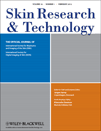Patterns of aluminum hydroxychloride deposition onto the skin
Abstract
Background: Aluminum hydroxychloride (AlCl3) is an antiperspirant.
Aim: To revisit the AlCl3 deposition in vivo and in vitro on glass slides and stratum corneum (SC) harvested by cyanoacrylate skin surface strippings (CSSS).
Methods: Transepidermal water loss (TEWL) was assessed following application of 5% AlCl3 on the forearms. The AlCl3-coated skin, glass slides and CSSS were observed using two ultraviolet light-emitting CCD cameras in order to record changes in specular reflectance related to AlCl3 deposition. In addition, the corneoxenometry bioassay was performed in order to predict AlCl3 irritation.
Results: AlCl3 deposited on glass slides looked as linear threads and rings of similar sizes. AlCl3 deposits on skin were almost restricted inside the microrelief lines and as annular deposits at their crossings where acrosyringia are opening. After daily AlCl3 applications, deposits extended on the CSSS plateaus. At rest in absence of sweating, TEWL was decreased following AlCl3 applications. During physical exercise, the TEWL increase was limited on the AlCl3 areas. CSSS appeared unreactive to AlCl3 at the corneoxenometry bioassay.
Conclusion: The similar aspect of AlCl3 deposits on human SC and on glass slides suggested a physical property of AlCl3. Repetitive applications of AlCl3 increased both the deposit area and the barrier function.




